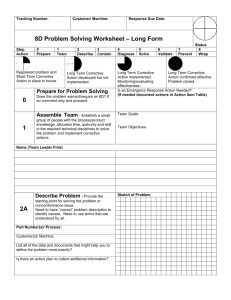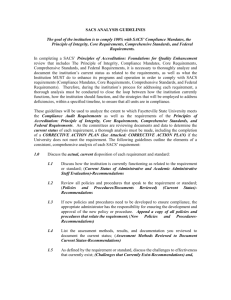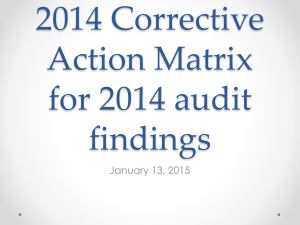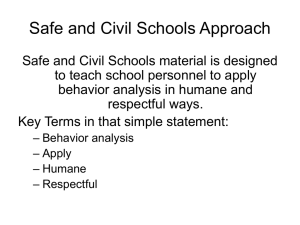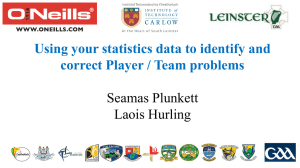WHAT is Corrective Instruction? - DPS
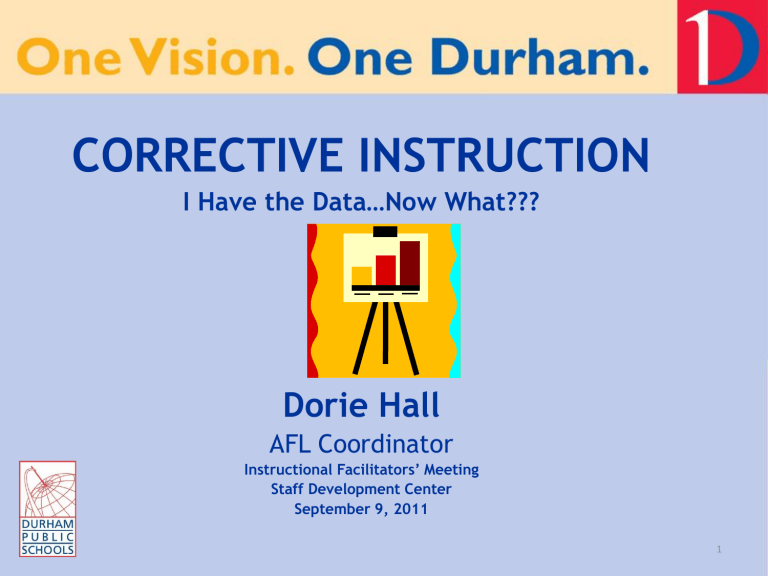
CORRECTIVE INSTRUCTION
I Have the Data…Now What???
Dorie Hall
AFL Coordinator
Instructional Facilitators’ Meeting
Staff Development Center
September 9, 2011
1
Today’s Task
• To understand how to respond to SGA/CA data on the day(s) immediately after the assessment
• To participate in an item analysis exercise
• To examine the Corrective Instruction Toolkit and discuss steps for implementation
EXAMINE and UNPACK STANDARDS
Curriculum Overview
Instruction and Assessment
Calendar
Learning Targets and
Progressions
CALIBRATE RIGOR and DESIGN ASSESSMENT
Local Assessments
Minute by Minute
Assessments
Common Formative
Assessments
PLAN and DELIVER INSTRUCTION
Instructional Strategies
Gradual Release of Responsibility
Student Ownership and
Engagement
Descriptive Feedback
TODAY’S
Standards, Item Analysis,
TASK
Student Responses
ASSESS and ANALYZE DATA
Teacher and Student
Reflection
Looking at Student Work
DETERMINE MASTERY and COMMUNICATE RESULTS
Corrective Instruction
Focused Revision Standards -Based Grading
Enrichment
Corrective Instruction
• What’s the MUDDIEST POINT for teachers?
• What is CRYSTAL CLEAR for teachers?
WHAT is Corrective Instruction?
• Instructional strategies provided to students who demonstrate non-mastery of standards
• Designed to correct specific misconceptions
• Involves different strategies than those used during initial instruction
• Enrichment exercises provided to students who demonstrate mastery of standards
Corrective Instruction Continuum
Novice Practicing Expert
TEACHERS
STUDENTS
PARENTS
Limited understanding of expectations and planning procedures
Limited understanding of purpose and expected outcomes
Limited understanding of purpose and expected outcomes
Provides general review of assessment items/standards to whole group
Aware of overall assessment score and need for class review
Aware of schedule, student needs/expectations
Practices proactive planning, Establishes flexible groups amongst/across teams to differentiate instruction
Complete understanding of strengths/weakness by standard and differentiated schedule/instruction
Complete understanding of how to provide support outside of school
WHEN should Corrective Instruction occur?
• SHORT TERM
– 1-2 days following SGA/CA
• LONG TERM
– Continuously throughout the quarter
WHEN should Corrective Instruction occur?
Monday Tuesday Wednesday Thursday Friday
14 September 15 September
Standard 1.05
16 September 17 September 18 September
SGA Item Analysis and
Corrective
Instruction
SGA Item Analysis and
Corrective
Instruction
(1.07, 1.05) (1.07, 1.05)
SGA
(1.07, 1.05)
HOW should Corrective Instruction be delivered?
PHASE 1: Short Term
– Day 1: Item Analysis Lesson
• Assessment Reflection
• Assessment Correction
– Day 2: Item Analysis Lesson Cont’d or
Flexible Groups
Item Analysis Exercise
• Review the SGA and Item Analysis Report
• Sort the items according to performance bands by placing each one in either the red, yellow, orange, or green sections
• Complete Item Analysis Teacher Worksheet
Item Analysis Report
CORRECTIVE INSTRUCTION TOOLKIT
• “How Classroom Assessments Improve
Learning” Article
• Item Analysis Teacher Worksheet
• Item Analysis Lesson Plan
• Assessment Reflection Student Worksheet
• Assessment Correction Student Worksheet
– Math and Reading
Teacher “Look Fors”
During PLCs
• Access, Review, and
Analyze Big 4
• Complete Classroom Data
Analysis Worksheet
• Update Class Data
Notebook/Chart
• Refer to unpacked standards to identify specific misconceptions
During Instruction
• Provide and review
Individual Student Reports
• Update Student Data
Notebook/Chart
• Completion of
Assessment Reflection and
Correction worksheets
Student “Look Fors”
During Class
• Review Student Report
• Update Data Notebook
• Complete Assessment
Reflection and Correction worksheet
Beyond Class
• Parent Communication
• Spiraling Homework
• Tutoring
• Parental Support
Things to Consider…
• 2 Phases
– Short and Long Term
• Start Small
– Professional Development
– Implementation
– Monitoring
– REPEAT!
• Collaboration
– Tutors, Parents, Media Coordinator, Elective Teachers
Next Steps…
• Read article “How Classroom Assessments Improve
Learning”
• Identify where your school is on the continuum and identify a growth area
• Plan Professional Development
– Weekly PLCs
– Early Release Day


